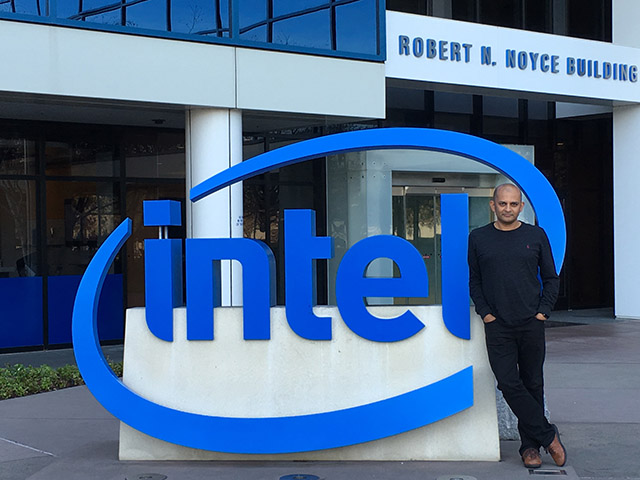Intel Interview: Gamification proving its relevance to education
By Ryan Noik 12 September 2016 | Categories: interviews
Gaming has come a long way from when it was viewed as solely a niche hobby, enjoyed primarily by young males sitting in darkened, screen-lit rooms. The pastime has not only grown up to become a significant form of entertainment in its own right, enjoyed by a broad swathe of users, it is also proving its mettle as offering a myriad of socially conscious benefits as well.
This is largely due to one of its most interesting outgrowths, gamification, which uses principles inherent in game dynamics to make learning and even working smoother. Its applications in the real world seem to be endless, ranging from helping people to drive better, stay healthier and even making education considerably more engaging and fun.
Hitendra Naik, the director of innovation for Middle Star, Turkey and Africa at Intel, explained that in a nutshell gamification uses game elements in a non game context. He differentiates gamification from game-based learning, which uses traditional games to teach people. Rather, while gamified apps are not full game offerings, they do include certain familiar elements such as offering feedback and giving users the chance to fail but then try again.

Hitendra Naik, the director of innovation for Middle East, Turkey and Africa
Carrot, rather than the stick
A prime example of this could be a medical aid which rewards users for the number of steps they walk and how healthy they stay on an ongoing basis, which in turn affects the rate they receive. In a similar fashion, insurance companies can offer a gamified app, where users opt to have their driving speed tracked, and aim to move up in ‘rankings’ to achieve higher rewards, which could include a free cup of coffee from participating coffee stores to preferable rates on their car insurance.
He elaborates that this carrot-rather-than-stick approach to engaging users has numerous advantages when used effectively, including fostering motivation and building a stronger emotional connection to particular content.
Additionally, another benefit that has particular relevance to education and training scenarios, Naik notes, is that using a gamified approach has shown to provide a tenfold increase in retention in long term memory. Whether being used by salespeople to retain information about a product they are selling or applied to those learning new skills, this alone makes the case for gamification being far from a frivolous pursuit.
“The prevailing question is how can we gamify education so as to encourage greater student participation, as there is a direct link between whether students find school interesting and their success,” he continues.
The good news, for Africa at least, is that innovative approaches to learning and changing behaviour embodied in gamification may well find greater traction in less developed regions, and thus its benefits can be more accessible. “There is a willingness to change and adapt here, that seems to be less in developed countries, where there is greater resistance to changing longstanding models of education,” he elaborates.
Fusion of passions
While Intel has a long history with gaming itself, producing processors to enable the best gaming experience possible, Naik enthuses that another of the company’s passions is education, while gamification seems to offer the opportunity to be involved in both simultaneously.
However, he stressed that being involved in education is not simply about dropping numerous tablets in a school. Rather, making a meaningful difference to education is more complex, as enabling students to really succeed requires the right content (perhaps gamified where appropriate), along with training and a link to a curriculum, assessment and professional development.
Indeed, the company is already using gamification to drive digital literacy across Africa through its My Digital Journey Platform. Additionally, this initiative has a distinct focus on reaching out to women, a sweet irony considering that gaming was traditionally a male-dominated pastime.
Putting money where the mouth is
Naik elaborates that My Digital Journey is a web-based application with gaming mechanics where women are empowered to learn individually or in a facilitated environment, and with the support of a peer network. My Digital Journey uses case scenarios relevant to women in the form of challenges, which gives them the opportunity to practice solutions before moving on to the next level.
The platform is a new addition to the Intel She Will Connect programme, which aims to bridge the technology-gender gap, to teach young women how to leverage the internet and technology to pursue their goals.
He explains that Intel She Will Connect was introduced as a direct response to findings of the Women and the Web Report, which examined women’s access to and use of the internet in low and middle income countries. The report found that, on average, there are nearly 25% fewer women than men are online in developing countries. This represents a sizable 200 million fewer women than men online today. In Sub-Saharan Africa, the size of the gap is 43% - the largest across all the regions in the study.
The future beckons
As much as gamification can assist primary and high school learners to engage more fully with a subject, Naik believes that gamification, along with augmented and virtual reality, have their place in universities as well. The problem, he continues, is that institutions of higher education can be more deeply entrenched in tried and tested ways of educating.
And yet, the possibilities are tantalising, particularly with medical students in the near future being able to navigate their way through the human body in virtual reality, and then going on to become surgeons who could delve into simulations for certain types of surgeries.
“While there were many discussions in the past about whether gaming was good or bad for you, there is definitely a problem solving element, where players need to get past different levels, fail only to come back and try again. This inculcates a problem-solving mentality,” he adds. Moreover, he stresses the importance of teaching people at an early age how to solve problems, while simultaneously fostering a creative and innovative spirit.
This it seems, has only become more relevant in the light of disruption and the need for businesses – and employees – to be more innovative than before in the face of change. Ironically, while gamification has been born from a fun pasttime, it may well hold a vital key to coping, and more importantly thriving, in the 21st century.
Most Read Articles

Have Your Say
What new tech or developments are you most anticipating this year?



